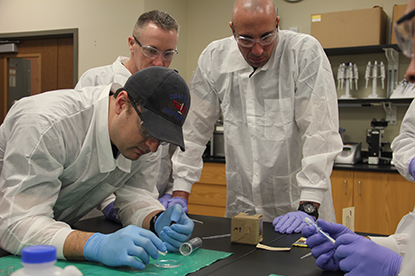
| Feb. 2017 | |||||||||||
| Top stories | |||||||||||
| In the news | |||||||||||
| Photos | |||||||||||
| Contact us | |||||||||||
| Archive | |||||||||||
|
Treimer helps responders navigate job hazards |
Feb. 28, 2017 --
More than four million facilities in the United States manufacture, use or store hazardous materials (HazMat). It’s no surprise that these chemicals are common in some industries. The Department of Homeland Security reports that hazardous materials also may be found in everyday settings such dry cleaners, gas stations, hospitals, residential garages and households.
 A member of the Cedar Rapids HazMat response team uses a small quantity of a collected sample to run one of several field identification tests to determine the identity of the unknown sample.
A member of the Cedar Rapids HazMat response team uses a small quantity of a collected sample to run one of several field identification tests to determine the identity of the unknown sample.These chemicals are corrosive, explosive, pathogenic, asphyxiating or delivered in other dangerous forms. It’s when these are released into the environment – either by accident or with the intent of doing harm – that a hazardous material may become a chemical threat.
Rural states like Iowa may not receive as many HazMat emergency calls as states with larger populations. Regardless, Iowa first responders still are required to have the same level of training for hazardous material emergencies to be prepared for whenever the next call comes.
For the last 11 years, environmental lab scientist Steve Treimer has worked directly with HazMat teams to help with preparedness. This year, he led the annual supplemental training, which helps provide hours toward continuing education requirements necessary to maintain the Hazardous Materials Technician certification. Though each department self-certifies their technicians, typically technicians require a minimum of eight hours additional training in hazardous materials to maintain their certification, in addition to the initial 80-hour certification course. The one-day sessions were available from Feb. 13 to 15 at the Hygienic Laboratory’s Center for the Advancement of Laboratory Science (CALS).
“Using the CALS to provide hands-on demonstrations and samples for the technicians to employ their own equipment builds confidence and experience in a controlled setting,” Treimer said.
Dressed in lab coats, goggles and gloves, a total of 48 members of the 71st Civil Support Team and firefighters from Cedar Rapids, Davenport, Ottumwa and Muscatine worked with Treimer to sharpen their skills.
“We wanted to focus on the protocols surrounding sampling and identification of unknown powders and liquids in the field,” Treimer said.
Two recent emergency events were used as training scenarios to demonstrate the real world threats. Emphasis was on recognizing a hazardous substance and collecting samples without exposing the first responders or others.
In Iowa, there has been a surge in the number of emergency calls about overdoses from controlled substances. Proper handling of these hazardous materials is a matter of public safety as well as protecting those who serve the public.
Disease Control Division Director Wade Aldous drew on his 20-year military experience to demonstrate how a tool called a handheld assay is used to detect potential biological unknowns.
The first responders “have used these devices over the last couple years to identify five possible select agents in the field, but have never had formal training in the selectivity and specificity,” Treimer said. “Having Dr. Aldous draw from his 20 years of work in the military was a terrific benefit for the teams.”